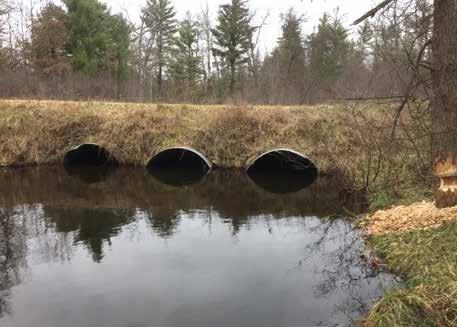
3 minute read
Watershed-Scale Habitat Reconnection

by Jeremy Geist, TU Great Lakes Stream Restoration Manager
Advertisement
By now, many of us are aware of the problems when roads and streams meet. The stream’s flow regime and other natural processes, such as sediment and organic matter transport, are impacted if the culvert it flows through is too small. Additionally, fish and other aquatic organism passage is restricted by the often-increased water velocities associated with undersized culverts (think of when you place a thumb at the end of a water hose).
Threats to the structural integrity of the road and the culvert occur if the road/stream crossing is inadequate. Increased pressure during high flow events (large amounts of rain that are increasingly becoming more common) upstream of the crossing (ponding) poses a risk to the stability of the crossing and, in worst-case scenarios, can lead to road failure. Additionally, increased water velocities through the culvert (or bridge structure) can cause scour, further threatening road stability. Overall, poorly designed or failing road/stream crossings threaten the health of both streams and roadways.
These poorly designed and failing road/stream crossings are ubiquitous across the landscape. Recent studies show that there are 38 times as many road crossings as dams in the Great Lakes region, and roughly two-thirds are partially or wholly impassable to fish. Therefore, river habitat is fragmented by road systems. Since fish need access to multiple habitat types in a river system throughout the year and during their life span, our road networks are likely negatively impacting fish populations.
Since problematic road/stream crossing are so common, how does one prioritize efforts and resources to help alleviate the issue? This question is not easily answered and is influenced by a multitude of factors from both an infrastructure and fisheries perspective. Some of those factors include available funding, quality of the river/status of the fishery, existing road and culvert conditions, partners’ willingness to assist, common interests of partners, and priorities.
TU has been working to help identify areas and watersheds to direct efforts and improve river/habitat connectivity across the Great Lakes region. For example, through a comprehensive prioritization strategy that includes multiple partnerships, watershed-scale habitat reconnection efforts have been taking place over the last seven years in Bigelow Creek (Muskegon River tributary) and Hinton Creek (Manistee River tributary). These two tributaries are highquality coldwater streams that support robust brook and other wild trout populations. In addition, there is overlapping interest and priorities within these watersheds for both road and habitat improvement resulting in a multi-partnership effort to replace failing or inadequate culverts.
Since 2016, TU and the USDA Forest Service – Huron Manistee National Forest, Muskegon River Watershed Assembly, MDNR, the Newaygo County Road Commission, Wexford County Road Commission, Natural Resource Conservation Service, and many other partners have been working in the Bigelow Creek and Hinton Creek watershed to address problem road/stream crossings. To date, six road/ stream crossings have been improved, reconnecting over 25 miles of coldwater habitat in Bigelow Creek. At Hinton Creek, seven road/stream crossings have been improved, reconnecting over 15 miles of habitat. The project teams are planning to replace one or two more crossings during 20222023 over Hinton and Bigelow Creeks, which will result in the complete reconnection of both watersheds.
Complementing this effort and others around the region and nation, the recent passing of the Infrastructure Investment and Jobs Act will significantly increase the availability of funds for continued culvert replacements in the coming years. This act will result in an unprecedented investment of $1.2 trillion in infrastructure projects, delivering a major shot in the arm to trout and salmon conservation efforts across the country.
Up to $1 billion will be made available nationally to federal agencies and state governments for programs that can be used to remove, replace, and restore culverts that fish cannot pass, and tens of millions of dollars for collaborative approaches to restoration of rivers and streams. The Act also contains significant investments in some of TU’s highest priority watersheds, including the Great Lakes region. TU’s longstanding and effective relationships with the agencies will help ensure that these resources produce major results for trout and salmon.
Finding the overlap between infrastructure and river restoration priorities fosters multi-partnership efforts to improve both road and stream systems. This combined interest results in more resources allocated towards improving these intersections of roads and streams and, overall, helps improve conditions regarding flood resiliency, road integrity, and ecosystem health.

